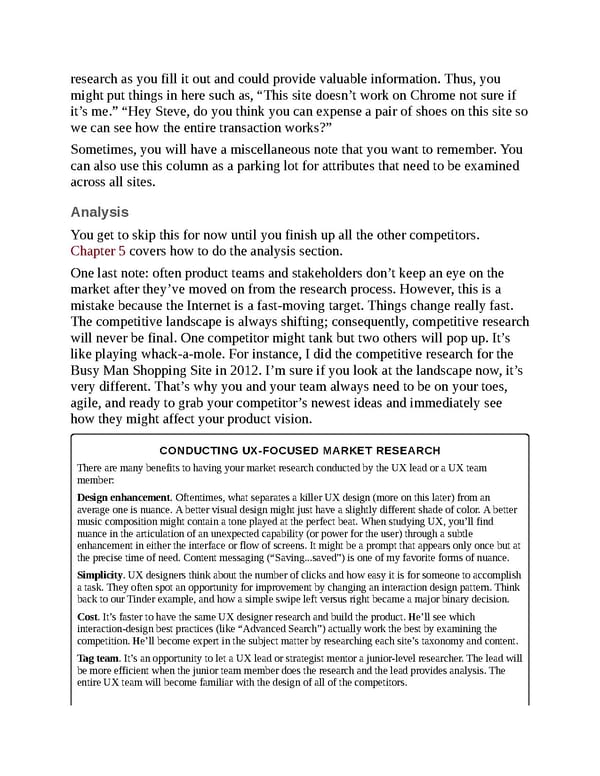research as you fill it out and could provide valuable information. Thus, you might put things in here such as, “This site doesn’t work on Chrome not sure if it’s me.” “Hey Steve, do you think you can expense a pair of shoes on this site so we can see how the entire transaction works?” Sometimes, you will have a miscellaneous note that you want to remember. You can also use this column as a parking lot for attributes that need to be examined across all sites. Analysis You get to skip this for now until you finish up all the other competitors. Chapter 5 covers how to do the analysis section. One last note: often product teams and stakeholders don’t keep an eye on the market after they’ve moved on from the research process. However, this is a mistake because the Internet is a fast-moving target. Things change really fast. The competitive landscape is always shifting; consequently, competitive research will never be final. One competitor might tank but two others will pop up. It’s like playing whack-a-mole. For instance, I did the competitive research for the Busy Man Shopping Site in 2012. I’m sure if you look at the landscape now, it’s very different. That’s why you and your team always need to be on your toes, agile, and ready to grab your competitor’s newest ideas and immediately see how they might affect your product vision. CONDUCTING UX-FOCUSED MARKET RESEARCH There are many benefits to having your market research conducted by the UX lead or a UX team member: Design enhancement. Oftentimes, what separates a killer UX design (more on this later) from an average one is nuance. A better visual design might just have a slightly different shade of color. A better music composition might contain a tone played at the perfect beat. When studying UX, you’ll find nuance in the articulation of an unexpected capability (or power for the user) through a subtle enhancement in either the interface or flow of screens. It might be a prompt that appears only once but at the precise time of need. Content messaging (“Saving...saved”) is one of my favorite forms of nuance. Simplicity. UX designers think about the number of clicks and how easy it is for someone to accomplish a task. They often spot an opportunity for improvement by changing an interaction design pattern. Think back to our Tinder example, and how a simple swipe left versus right became a major binary decision. Cost. It’s faster to have the same UX designer research and build the product. He’ll see which interaction-design best practices (like “Advanced Search”) actually work the best by examining the competition. He’ll become expert in the subject matter by researching each site’s taxonomy and content. Tag team. It’s an opportunity to let a UX lead or strategist mentor a junior-level researcher. The lead will be more efficient when the junior team member does the research and the lead provides analysis. The entire UX team will become familiar with the design of all of the competitors.
 UX Strategy: How to Devise Innovative Digital Products that People Want Page 104 Page 106
UX Strategy: How to Devise Innovative Digital Products that People Want Page 104 Page 106